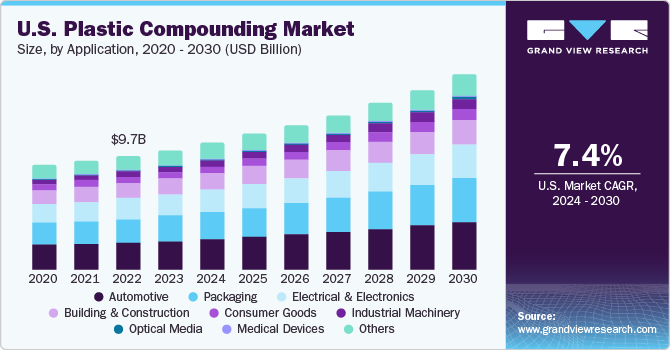The global plastic compounding market size is projected to reach USD 95.29 billion by 2026, according to a new report by Grand View Research, Inc. It is anticipated to expand at a CAGR of 6.7% during the forecast period. Rapidly developing construction and automobile markets are anticipated to drive the demand for interiors, exteriors, and under hood components. Maximum applications of plastics compounding involve under hood components in the automotive industry, building interior and exteriors in construction and infrastructure industries, and in electronics, durables, and wire and cable industries.
Polyethylene terephthalate known as PET, is the plastic used for manufacturing bottle containers used for packaged water and carbonated beverages. As a raw material, PET is recognized worldwide as a safe, strong, flexible, non-toxic, and lightweight material that is 100% recyclable. Hence, it has gained wide acceptability and is anticipated to lead the plastic compounding market growth over the forecast period.
Asia Pacific was the leading revenue generator for PET compound segment in 2018. Ever increasing demand for beverages, mainly carbonated beverages and nutritional drinks, is anticipated to drive the regional consumption of PET compound. This trend is favored by rise in population, changing lifestyle, and emergence of domestic beverage manufacturers. Presence of large pool of contract bottlers in the region shall also impact the scope of packaging application in Asia Pacific.
Traditionally, construction industry has been a major consumer of plastics with the product application ranging from pipe fittings and insulation to masonry materials and equipment. Plastic compounds are modified in accordance to their requirements, e.g. flame retardant additives are added to PVC compounds, and form a very crucial aspect of building materials.
Developing countries such asMexico are expected to benefit from rising construction spending and inclination of consumers to utilize sustainable and lightweight building materials in place of conventional materials. The expanding automotive sector and shift in consumer purchase behavior from considering cars as luxuries to now considering them necessities are also anticipated to have a positive impact on the plastics sector and drive compounding activities in the region.

To request a sample copy or view summary of this report, click the link below:
Further key findings from the report suggest:
- In terms of revenue and volume, polypropylene is the most consumed plastic compounding product. The rise in its production is owing to high demand from packaging and medical device industries across the globe
- Increasing requirement for flame retardancy, heat resistance, and improved serviceability is anticipated to drive growth in electronics and electrical industry
- Construction is the leading application segment for polyethylene compounds with the segment accounting for a mass application globally
- Major plastic compound manufacturers have been acquiring independent compounding facilities, rather than establishing plants, to strengthen their position
- Key players operating in the plastic compounding market include BASF SE., LyondellBasell Industries, N.V., and The Dow Chemical Company